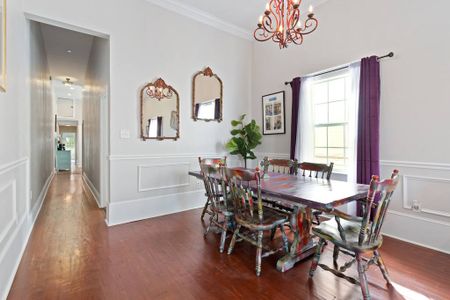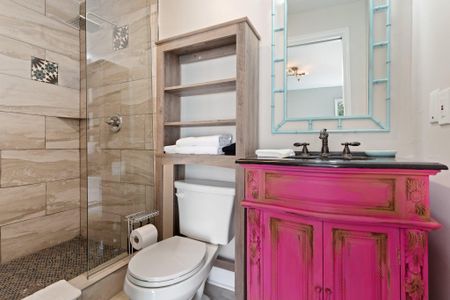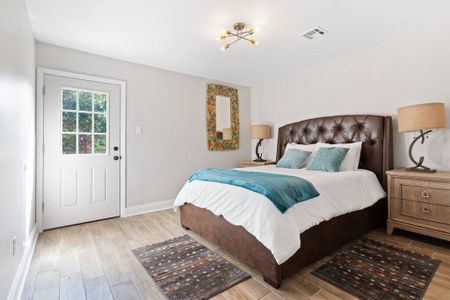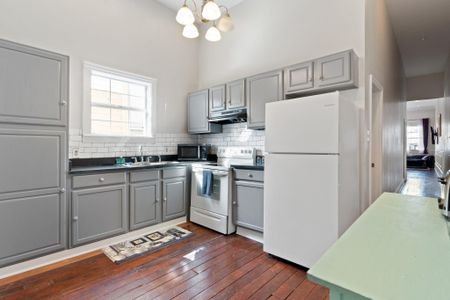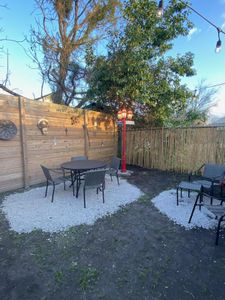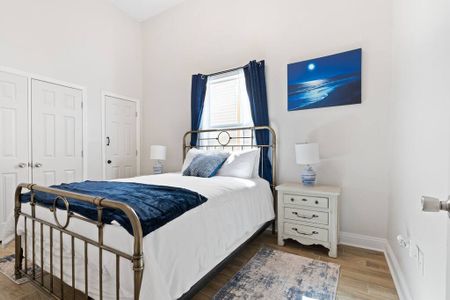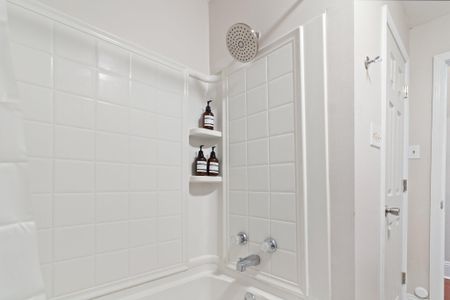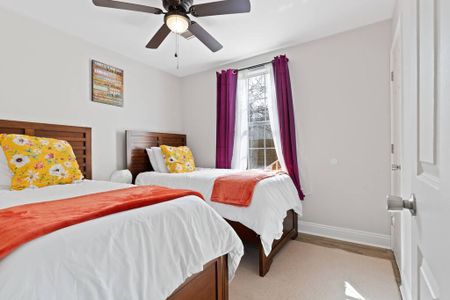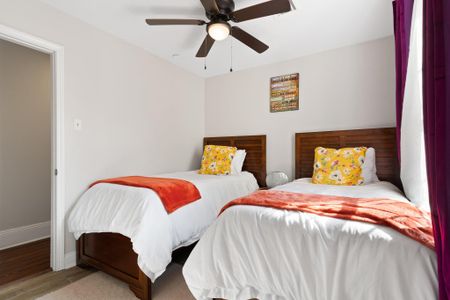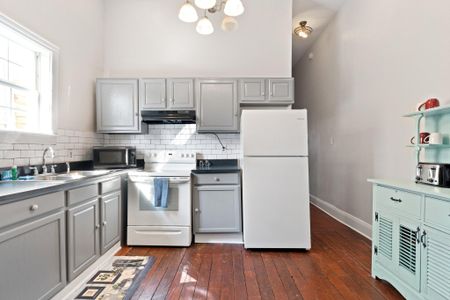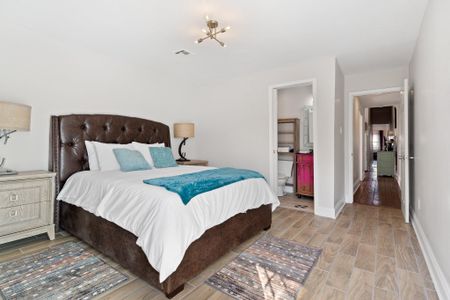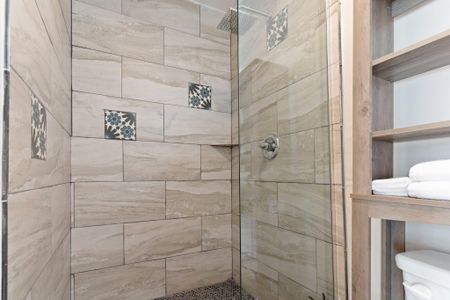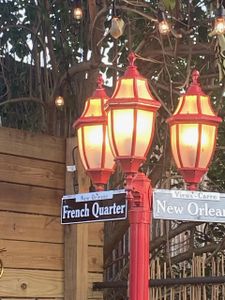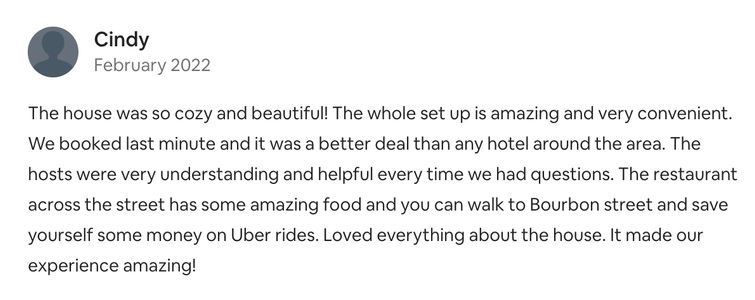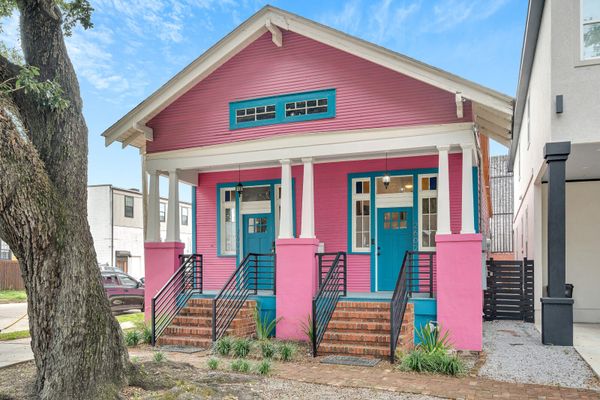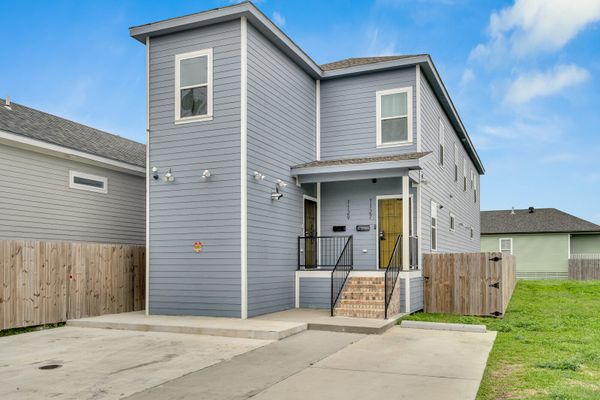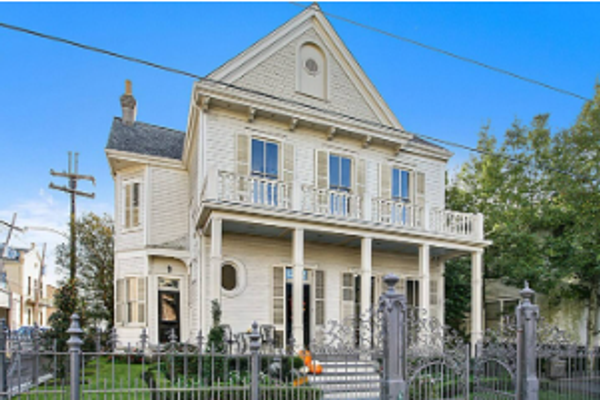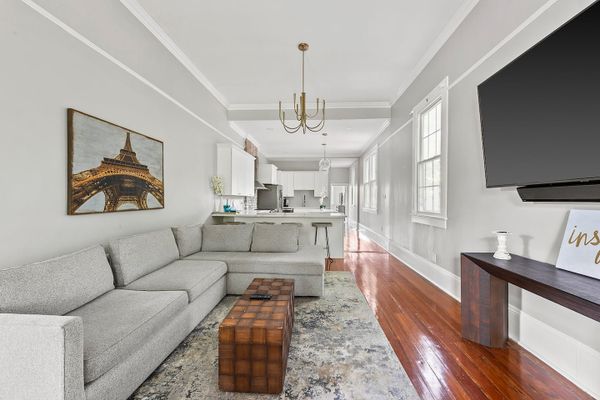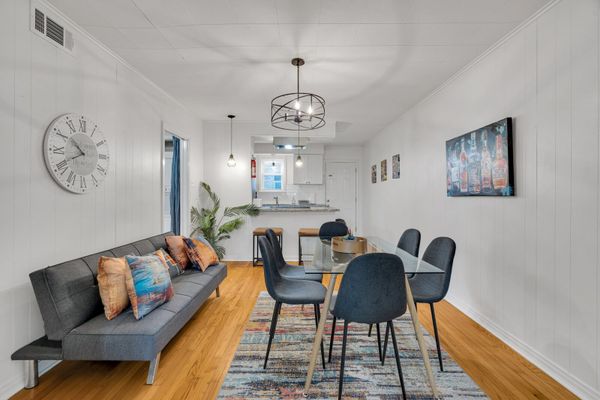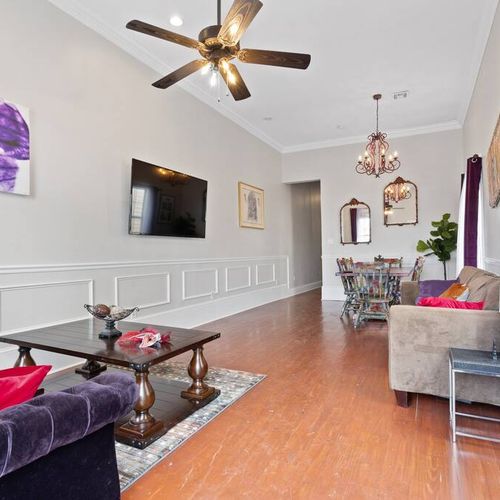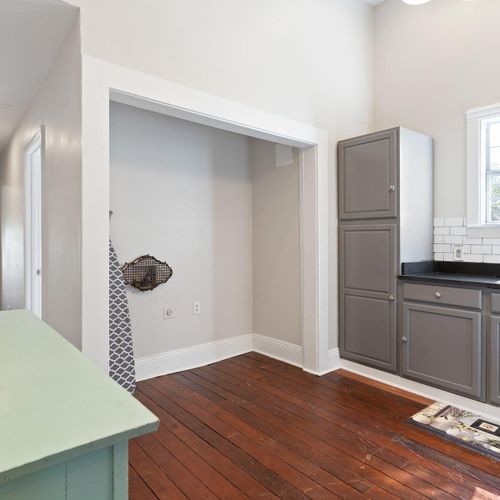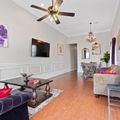Fais Do-Do Lodge
-
Marigny
-
Duplex
6
Guests
3
Bedrooms
2
Bathrooms
Discover New Orleans from our three-bedroom, blending modern design with traditional NOLA charm. Centrally located, it’s a short drive to downtown, the vibrant St. Roch market in Bywater, and the lively Frenchman Street, famous for its restaurants, bars, and music. Take a short walk to Melba’s for late night daiquiris and authentic creole cuisine and enjoy a quiet respite on our local-styled backyard.
Show Full Description
Notes
• Normal check-in time is 4pm on the arrival date. For check-in's from 1pm - 4:00pm, it's an extra $50 to have an extra cleaner assist with servicing the property. Check-in's before 1pm would require booking the previous night at a much discounted rate. Contact host for details.
**We require a separate Rental Agreement to be e-signed followed your booking!**Please review the house rules located in the rental agreement prior to booking.
*Our space is not handicapped accessible or ADA compliant*
*Pack-n-play/highchairs must be reserved.
*Important: For non-Airbnb guests only - Our properties are protected and insured by Safely - a globally recognized trust and safety company that allows hosts and guests to confidently transact.
-Please note that once you have booked, you will be contacted via email by Safely to complete your booking validation, which includes ID verification and confirmation of other minor details.
**We require a separate Rental Agreement to be e-signed followed your booking!**Please review the house rules located in the rental agreement prior to booking.
*Our space is not handicapped accessible or ADA compliant*
*Pack-n-play/highchairs must be reserved.
*Important: For non-Airbnb guests only - Our properties are protected and insured by Safely - a globally recognized trust and safety company that allows hosts and guests to confidently transact.
-Please note that once you have booked, you will be contacted via email by Safely to complete your booking validation, which includes ID verification and confirmation of other minor details.
Neighborhood
The French Quarter is New Orleans’ oldest and most expensive neighborhood, but homeowners who seek its densely urban layout, historic appeal, and walkability can find those same attributes in the neighboring Marigny Triangle. In some ways, the Marigny Triangle is superior to the French Quarter: sandwiched between the Vieux Carre and the trending Bywater, it enjoys proximity to amenities in both neighborhoods. This home is ideally located only short distances to numerous New Orleans landmarks, including Frenchman Street (1.0 Miles), Jackson Square (1.4 Miles), New Orleans Jazz Museum (1.0 Miles), and Caesar's Superdome/Smoothie King Center (2.4 Miles).
Faubourg Marigny
Residents of the Faubourg (an ancient French term for "suburb") Marigny are very proud of their neighborhood...and who can blame them?
Here in this small wedge of real estate located just downriver from the French Quarter, you'll find everything that makes New Orleans a uniquely wonderful place. The jazz clubs lining Frenchmen Street are world-famous, and every night you can hear big-name acts jamming with the hippest stars of tomorrow. The Marigny is home to some of the city's trendiest restaurants: places where new chefs constantly reinvent the city's cuisine. Neighborhood galleries and antique stories offer gems for every pocketbook, from museum-quality art to thrift-shop chic. And the area's eclectic late Georgian, Creole, and Greek Revival houses nestle closely together, forming a fascinating and varied cityscape.
The Marigny's boundaries as defined by the City Planning Commission are: North Rampart Street and St. Claude Avenue to the north, Franklin Avenue to the east, the Mississippi River to the south and Esplanade Avenue to the west.
The Marigny was laid out in the first decade of the 19th century by eccentric Creole millionaire developer Bernard Xavier Philippe de Marigny de Mandeville on land that had been his family plantation, just downriver from the old city limits of New Orleans. The portion of the Marigny closer to the river was built up first; the area on the side of St. Claude Avenue (formerly "Goodchildren Street") away from the river was sometimes called "New Marigny".
Elysian Fields Avenue, named after the Champs-Élysées in Paris, was designed to be the main street of the Faubourg Marigny. It was the first street in New Orleans to extend all the way from the riverfront straight to Lake Pontchartrain, 8 km (5 miles) away. From 1830-31, the Pontchartrain Railroad was built, with tracks running down the center of Elysian Fields. The area at the other end of the rail line developed into Milneburg. Marigny's town square, Washington Square, fronts Elysian Fields.
The neighborhood declined in the mid-20th century, but came back strong in the late 20th century. After profiteering centered around the 1984 World's Fair drove many long-term residents from the French Quarter into the Marigny. Frenchmen Street soon developed the city's premier collection of live music venues and restaurants, and is a popular destination for both locals and knowledgeable out-of-towners.
If you have any questions about the neighborhood, please send us a message!
Faubourg Marigny
Residents of the Faubourg (an ancient French term for "suburb") Marigny are very proud of their neighborhood...and who can blame them?
Here in this small wedge of real estate located just downriver from the French Quarter, you'll find everything that makes New Orleans a uniquely wonderful place. The jazz clubs lining Frenchmen Street are world-famous, and every night you can hear big-name acts jamming with the hippest stars of tomorrow. The Marigny is home to some of the city's trendiest restaurants: places where new chefs constantly reinvent the city's cuisine. Neighborhood galleries and antique stories offer gems for every pocketbook, from museum-quality art to thrift-shop chic. And the area's eclectic late Georgian, Creole, and Greek Revival houses nestle closely together, forming a fascinating and varied cityscape.
The Marigny's boundaries as defined by the City Planning Commission are: North Rampart Street and St. Claude Avenue to the north, Franklin Avenue to the east, the Mississippi River to the south and Esplanade Avenue to the west.
The Marigny was laid out in the first decade of the 19th century by eccentric Creole millionaire developer Bernard Xavier Philippe de Marigny de Mandeville on land that had been his family plantation, just downriver from the old city limits of New Orleans. The portion of the Marigny closer to the river was built up first; the area on the side of St. Claude Avenue (formerly "Goodchildren Street") away from the river was sometimes called "New Marigny".
Elysian Fields Avenue, named after the Champs-Élysées in Paris, was designed to be the main street of the Faubourg Marigny. It was the first street in New Orleans to extend all the way from the riverfront straight to Lake Pontchartrain, 8 km (5 miles) away. From 1830-31, the Pontchartrain Railroad was built, with tracks running down the center of Elysian Fields. The area at the other end of the rail line developed into Milneburg. Marigny's town square, Washington Square, fronts Elysian Fields.
The neighborhood declined in the mid-20th century, but came back strong in the late 20th century. After profiteering centered around the 1984 World's Fair drove many long-term residents from the French Quarter into the Marigny. Frenchmen Street soon developed the city's premier collection of live music venues and restaurants, and is a popular destination for both locals and knowledgeable out-of-towners.
If you have any questions about the neighborhood, please send us a message!
Access
Guests will have uninterrupted access to the entirety of this home - 3 bedrooms, 2 bathrooms, kitchen, living area, laundry and backyard space.
Space
Completely private space, three bedrooms, two of which have 2 beds, 2 bathrooms, a lovely kitchen space with all the basic accommodations you'll need while visiting us. A washer and dryer in unit. Backyard space with chairs and a table for your comfort!
Trashcans should be outside next to the stairs when entering the unit.
Trashcans should be outside next to the stairs when entering the unit.
Transit
French Quarter: 0.9 miles | 19 min walk | 4 min drive | $5 Uber
Frenchmen Street: 0.6 miles | 14 min walk | 3 min drive | $5 Uber
Superdome: 2.2 miles | 44 min walk | 8 min drive | $9 Uber
Convention Center: 2.6 miles | 52 min walk | 10 min drive | $11 Uber
Nearest Streetcar Stop: 0.4 miles
Airport Transportation: We have partnered with a local transportation company, Jazzy Limousine and Shuttle, to offer discounted transportation to/from the Airport!
Parking: Street parking is available but cannot be guaranteed. When utilizing street parking, please ensure adherence to city and state laws.
Frenchmen Street: 0.6 miles | 14 min walk | 3 min drive | $5 Uber
Superdome: 2.2 miles | 44 min walk | 8 min drive | $9 Uber
Convention Center: 2.6 miles | 52 min walk | 10 min drive | $11 Uber
Nearest Streetcar Stop: 0.4 miles
Airport Transportation: We have partnered with a local transportation company, Jazzy Limousine and Shuttle, to offer discounted transportation to/from the Airport!
Parking: Street parking is available but cannot be guaranteed. When utilizing street parking, please ensure adherence to city and state laws.
Rooms and Beds
Room #1
queen beds: 1
1
Room #2
single beds: 2
2
Room #3
queen beds: 1
3
Features and Amenities
Air Conditioning
Allows Children
Baby High Chair
Baby Travel Bed
Babysitter Recommendations
Baking Sheet
Bathtub
Body Soap
Carbon Monoxide Detector
Ceiling Fan
Check In Option Instruction
Chef’s kitchen
Rates and Availability
Taxes and fees are additional
Reviews
Great location, house was perfect and the beds were so
Heather
Great location, house was perfect and the beds were so comfortable! Would book again
Our stay was so wonderful! Mike always responded very quickly,
Dayna
Our stay was so wonderful! Mike always responded very quickly, even close to midnight when we had trouble with our keys. The place was very clean, comfortable, and perfect for our long weekend. It was close to the French Quarter, Frenchmen Street, and local restaurants. It isn’t on a busy street so it was quiet and felt safe. We were in town for Taylor Swift so the price was a bit steep, but well worth it. I highly recommend staying here.
Great value and perfectly cute amenities
Erick
Great value and perfectly cute amenities
Very nice stay closer to everything
Christy
Very nice stay closer to everything
Total
Price Details
When
-
Explore Our Other Properties
Great location, house was perfect and the beds were so
Heather
Great location, house was perfect and the beds were so comfortable! Would book again
Our stay was so wonderful! Mike always responded very quickly,
Dayna
Our stay was so wonderful! Mike always responded very quickly, even close to midnight when we had trouble with our keys. The place was very clean, comfortable, and perfect for our long weekend. It was close to the French Quarter, Frenchmen Street,...
Great value and perfectly cute amenities
Erick
Great value and perfectly cute amenities
Very nice stay closer to everything
Christy
Very nice stay closer to everything
had issues with lockbox which Mike took care of immediately
Joshua
had issues with lockbox which Mike took care of immediately nothing to complain about. thanks for hosting us durning the hurricane back home.
We had a great stay at this Airbnb. After our
Érica
We had a great stay at this Airbnb. After our original booking had a leaking problem, we booked this place and checked-in same minute, and the hosts were really helpful. We had a small issue with the keys, but it was resolved quickly. The place wa...
Had some issue with getting in the lockbox but it
Mitchell
Had some issue with getting in the lockbox but it handle quickly. A great stay and the a/c works like the northpole.
The place was very nice and clean.
Stacy
The place was very nice and clean.
Great host! Responded quickly!
Shavell
Great host! Responded quickly!
The AirBnb was very nice, roomy, and comfortable! Everything was
Erianna
The AirBnb was very nice, roomy, and comfortable! Everything was nice and neat, things looked even better upon arrival. My family and I enjoyed sitting in the back yard area.
We had a great weekend getaway! The place was perfect
Bailey
We had a great weekend getaway! The place was perfect for the 4 of us, I would definitely recommend this airbnb to friends! The only downside of our stay were the streets surrounding us were a little skeptical, definitely not somewhere to walk aro...
Our stay at this charming Airbnb in New Orleans was
Dante
Our stay at this charming Airbnb in New Orleans was nothing short of magical. From the moment we stepped inside, we were greeted with the warmest hospitality and a true sense of Southern comfort. The cozy decor, complete with jazz-inspired artwork...
Everything about the house was great! My cousin’s and I
Vanessa
Everything about the house was great! My cousin's and I had a great time celebrating my birthday! It was the perfect sauce for six of us! Would recommend!!!
Great stay!
Joe
Great stay!
The host stayed in touch and was very responsive. Only
Danielle
The host stayed in touch and was very responsive. Only thing for me would say add tv in bedrooms but other than that everything was great.
Pictures didn’t do this place any justice! Very comfortable and
Nataia
Pictures didn't do this place any justice! Very comfortable and clean
The place was clean and as the pictures described. Beds
Katie
The place was clean and as the pictures described. Beds were very comfortable. The management was very corporate... but they got the job done... they were responsive and helpful.
We would definitely stay again whenever we are in town
Martin
We would definitely stay again whenever we are in town !
Place was perfect!!!
Justin
Place was perfect!!!
Had a great stay everything was very convenient for our
Kevin
Had a great stay everything was very convenient for our trip.
Hosts were very responsive. Addressed all concerns in a timely
Phil
Hosts were very responsive. Addressed all concerns in a timely manner.
Great location! Hosts were very responsive! Will definitely book again
Matiece
Great location! Hosts were very responsive! Will definitely book again the next trip!
My best friends and I truly enjoyed ourselves. The house
Ranita
My best friends and I truly enjoyed ourselves. The house was place right where it was convenient for us to get to all the places we need to get to on our trip. I will for sure rent again from Mike. I can’t wait to come back to New Orleans!!!!!
Very nice place. Close to bourbon street so the walk
Bena
Very nice place. Close to bourbon street so the walk wasn’t too bad. Would definitely stay again
Mike’s place was well kept, easy to find, and exactly
Daniel
Mike's place was well kept, easy to find, and exactly as described! Mike was able to quickly answer our (very few!) questions. The location was perfect for us to access New Orleans.
Way bigger than expected, great walking distance, super clean. Melba’s
Nathaniel
Way bigger than expected, great walking distance, super clean. Melba’s is a lifesaver!
Great place for a small family vacation.
Tara
Great place for a small family vacation.
Clean, spacious living room and responsive hosts.
Zach
Clean, spacious living room and responsive hosts.
Great host and house. Only thing is we had problems
Vanessa
Great host and house. Only thing is we had problems with the parking. Doesn’t have its own parking
10/10 Hand Down a great home with the perfect host.
Tahj
10/10 Hand Down a great home with the perfect host.
Great stay overall. We visited in October and the weather
Christopher
Great stay overall. We visited in October and the weather was perfect, so we opted for walking to nearby Frenchmen street. It was also easy to grab an Uber to many spots around the city. The house was presentable and matched the description well, ...
Definitely enjoyed my stay
Tia
Definitely enjoyed my stay
We had a great stay. The place was clean and
Mariel
We had a great stay. The place was clean and cute. Felt right at home. Beds were very comfortable. Very spacious rooms throughout the house. It’s just a few minutes from French quarter. Will definitely rent again.. ❤️❤️
This was a lovely stay! My friends and I had
Kristen
This was a lovely stay! My friends and I had a great time here. It was super close to everything we did. The beds were also very comfortable and it felt so homey.(:
Highly recommend this location, no nightmares, no pop up problems,
Stephen
Highly recommend this location, no nightmares, no pop up problems, easy access to all of New Orleans. You can’t go wrong with this choice!!! And if you have an opportunity go across the street to Melba’s Bill and Hilary did. 😀
Loved my stay at this place fit my group of
Jade
Loved my stay at this place fit my group of 5 perfect! Very spacious definitely would book same place if I return
Best idea is to park your car here and Uber
Steven
Best idea is to park your car here and Uber to the French quarter! Saves a ton of money and headaches.
Initially our concern was that we wouldn’t find street parking,
Geri
Initially our concern was that we wouldn’t find street parking, but surprisingly we didn’t have an issue at all during our entire stay we were able to park right outside. We received great recommendations from our host and all instructions were ve...
Nice place
Christopher
Nice place
If you’re looking for a place that’s a quick and
Raymond
If you’re looking for a place that’s a quick and easy Uber ride to all the fun that New Orleans has to offer than this is the place for you! Easy check in and checkout process! I would definitely recommend it to anyone that’s planning a trip to vi...
everything was great
Mary
everything was great
We had a wonderful stay. It was clean and perfect
Jake
We had a wonderful stay. It was clean and perfect for multiple people.
Great location, close to all the New Orleans has to
Mike
Great location, close to all the New Orleans has to offer.
This is a great location, close to the French quarter
Rachel
This is a great location, close to the French quarter and close to everything we wanted to do while on the trip!! The house is beautiful and was so clean! We had a great time!
Thoroughly enjoyed our stay here and how responsive the team
Secada
Thoroughly enjoyed our stay here and how responsive the team was when we had questions or concerns! The vicinity to French Quarter was perfect and we would certainly stay here again should be book any trips to NOLA in the future!
Communication and accuracy were phenomenal. This apartment is in a
Zac
Communication and accuracy were phenomenal. This apartment is in a great location for exploring the city. I would stay there again, anytime!
Just as pictured and just what we needed for a
Kelsy
Just as pictured and just what we needed for a bachelorette weekend for 6 of us. Not too far of an Uber to fun stuff. Not very safe of a neighborhood but that’s NOLA for you. Would recommend
Host respond quickly and are very helpful
Stephen
Host respond quickly and are very helpful
Great place to stay! Melba’s across the street was great
Brendan
Great place to stay! Melba’s across the street was great for late night and early morning eats, close to bourbon and Frenchman street!
Very nice stay! Great communication
Dajah
Very nice stay! Great communication
Exactly as described/pictured.
Bree
Exactly as described/pictured.
Great stay. Great host. I have no complaints!
Gabrielle
Great stay. Great host. I have no complaints!
We all loved the house!
Eilene
We all loved the house!
The house was amazing. A lot of room for 6
Elias
The house was amazing. A lot of room for 6 or more people. Lovely backyard.
We had a great time and really enjoyed our place.
Michael
We had a great time and really enjoyed our place. It was nice to have a kitchen, washer and dryer, and backyard patio.
Place was great parking was a bit tuff in a
Onae
Place was great parking was a bit tuff in a suburban
This place was a great space for a group of
Yesenia
This place was a great space for a group of 8. We had enough space to hang out. It was in a great location.
Excelente lugar
Emerson
Excelente lugar
We had a fabulous stay here. The house is lovely,
Hope
We had a fabulous stay here. The house is lovely, very clean, comfortable beds, and well-equipped. Every detail was taken care of and communication was quick and helpful. The location was great for getting around. Would definitely stay here ...
The house is great just how it looks on pictures,
Elena
The house is great just how it looks on pictures, easy to Uber anywhere. Restaurant across the street was a gem. I’d definitely stay here next time. They also sent me messages with suggestions which were helpful.
Everything was great. Thanks.
Miranda
Everything was great. Thanks.
Great spacious place, but you have to have a car
Vanessa
Great spacious place, but you have to have a car to travel around.
Very nice stay!! It was very clean when we arrived
Elaina
Very nice stay!! It was very clean when we arrived and it matched the pictures and description. We loved it!
The house was so cozy and beautiful! The whole set
Cindy
The house was so cozy and beautiful! The whole set up is amazing and very convenient. We booked last minute and it was a better deal than any hotel around the area. The hosts were very understanding and helpful every time we had questions. The res...
Notes
• Normal check-in time is 4pm on the arrival date. For check-in's from 1pm - 4:00pm, it's an extra $50 to have an extra cleaner assist with servicing the property. Check-in's before 1pm would require booking the previous night at a much discounted rate. Contact host for details.
**We require a separate Rental Agreement to be e-signed followed your booking!**Please review the house rules located in the rental agreement prior to booking.
*Our space is not handicapped accessible or ADA compliant*
*Pack-n-play/highchairs must be reserved.
*Important: For non-Airbnb guests only - Our properties are protected and insured by Safely - a globally recognized trust and safety company that allows hosts and guests to confidently transact.
-Please note that once you have booked, you will be contacted via email by Safely to complete your booking validation, which includes ID verification and confirmation of other minor details.
**We require a separate Rental Agreement to be e-signed followed your booking!**Please review the house rules located in the rental agreement prior to booking.
*Our space is not handicapped accessible or ADA compliant*
*Pack-n-play/highchairs must be reserved.
*Important: For non-Airbnb guests only - Our properties are protected and insured by Safely - a globally recognized trust and safety company that allows hosts and guests to confidently transact.
-Please note that once you have booked, you will be contacted via email by Safely to complete your booking validation, which includes ID verification and confirmation of other minor details.
Neighborhood
The French Quarter is New Orleans’ oldest and most expensive neighborhood, but homeowners who seek its densely urban layout, historic appeal, and walkability can find those same attributes in the neighboring Marigny Triangle. In some ways, the Marigny Triangle is superior to the French Quarter: sandwiched between the Vieux Carre and the trending Bywater, it enjoys proximity to amenities in both neighborhoods. This home is ideally located only short distances to numerous New Orleans landmarks, including Frenchman Street (1.0 Miles), Jackson Square (1.4 Miles), New Orleans Jazz Museum (1.0 Miles), and Caesar's Superdome/Smoothie King Center (2.4 Miles).
Faubourg Marigny
Residents of the Faubourg (an ancient French term for "suburb") Marigny are very proud of their neighborhood...and who can blame them?
Here in this small wedge of real estate located just downriver from the French Quarter, you'll find everything that makes New Orleans a uniquely wonderful place. The jazz clubs lining Frenchmen Street are world-famous, and every night you can hear big-name acts jamming with the hippest stars of tomorrow. The Marigny is home to some of the city's trendiest restaurants: places where new chefs constantly reinvent the city's cuisine. Neighborhood galleries and antique stories offer gems for every pocketbook, from museum-quality art to thrift-shop chic. And the area's eclectic late Georgian, Creole, and Greek Revival houses nestle closely together, forming a fascinating and varied cityscape.
The Marigny's boundaries as defined by the City Planning Commission are: North Rampart Street and St. Claude Avenue to the north, Franklin Avenue to the east, the Mississippi River to the south and Esplanade Avenue to the west.
The Marigny was laid out in the first decade of the 19th century by eccentric Creole millionaire developer Bernard Xavier Philippe de Marigny de Mandeville on land that had been his family plantation, just downriver from the old city limits of New Orleans. The portion of the Marigny closer to the river was built up first; the area on the side of St. Claude Avenue (formerly "Goodchildren Street") away from the river was sometimes called "New Marigny".
Elysian Fields Avenue, named after the Champs-Élysées in Paris, was designed to be the main street of the Faubourg Marigny. It was the first street in New Orleans to extend all the way from the riverfront straight to Lake Pontchartrain, 8 km (5 miles) away. From 1830-31, the Pontchartrain Railroad was built, with tracks running down the center of Elysian Fields. The area at the other end of the rail line developed into Milneburg. Marigny's town square, Washington Square, fronts Elysian Fields.
The neighborhood declined in the mid-20th century, but came back strong in the late 20th century. After profiteering centered around the 1984 World's Fair drove many long-term residents from the French Quarter into the Marigny. Frenchmen Street soon developed the city's premier collection of live music venues and restaurants, and is a popular destination for both locals and knowledgeable out-of-towners.
If you have any questions about the neighborhood, please send us a message!
Faubourg Marigny
Residents of the Faubourg (an ancient French term for "suburb") Marigny are very proud of their neighborhood...and who can blame them?
Here in this small wedge of real estate located just downriver from the French Quarter, you'll find everything that makes New Orleans a uniquely wonderful place. The jazz clubs lining Frenchmen Street are world-famous, and every night you can hear big-name acts jamming with the hippest stars of tomorrow. The Marigny is home to some of the city's trendiest restaurants: places where new chefs constantly reinvent the city's cuisine. Neighborhood galleries and antique stories offer gems for every pocketbook, from museum-quality art to thrift-shop chic. And the area's eclectic late Georgian, Creole, and Greek Revival houses nestle closely together, forming a fascinating and varied cityscape.
The Marigny's boundaries as defined by the City Planning Commission are: North Rampart Street and St. Claude Avenue to the north, Franklin Avenue to the east, the Mississippi River to the south and Esplanade Avenue to the west.
The Marigny was laid out in the first decade of the 19th century by eccentric Creole millionaire developer Bernard Xavier Philippe de Marigny de Mandeville on land that had been his family plantation, just downriver from the old city limits of New Orleans. The portion of the Marigny closer to the river was built up first; the area on the side of St. Claude Avenue (formerly "Goodchildren Street") away from the river was sometimes called "New Marigny".
Elysian Fields Avenue, named after the Champs-Élysées in Paris, was designed to be the main street of the Faubourg Marigny. It was the first street in New Orleans to extend all the way from the riverfront straight to Lake Pontchartrain, 8 km (5 miles) away. From 1830-31, the Pontchartrain Railroad was built, with tracks running down the center of Elysian Fields. The area at the other end of the rail line developed into Milneburg. Marigny's town square, Washington Square, fronts Elysian Fields.
The neighborhood declined in the mid-20th century, but came back strong in the late 20th century. After profiteering centered around the 1984 World's Fair drove many long-term residents from the French Quarter into the Marigny. Frenchmen Street soon developed the city's premier collection of live music venues and restaurants, and is a popular destination for both locals and knowledgeable out-of-towners.
If you have any questions about the neighborhood, please send us a message!
Access
Guests will have uninterrupted access to the entirety of this home - 3 bedrooms, 2 bathrooms, kitchen, living area, laundry and backyard space.
Space
Completely private space, three bedrooms, two of which have 2 beds, 2 bathrooms, a lovely kitchen space with all the basic accommodations you'll need while visiting us. A washer and dryer in unit. Backyard space with chairs and a table for your comfort!
Trashcans should be outside next to the stairs when entering the unit.
Trashcans should be outside next to the stairs when entering the unit.
Transit
French Quarter: 0.9 miles | 19 min walk | 4 min drive | $5 Uber
Frenchmen Street: 0.6 miles | 14 min walk | 3 min drive | $5 Uber
Superdome: 2.2 miles | 44 min walk | 8 min drive | $9 Uber
Convention Center: 2.6 miles | 52 min walk | 10 min drive | $11 Uber
Nearest Streetcar Stop: 0.4 miles
Airport Transportation: We have partnered with a local transportation company, Jazzy Limousine and Shuttle, to offer discounted transportation to/from the Airport!
Parking: Street parking is available but cannot be guaranteed. When utilizing street parking, please ensure adherence to city and state laws.
Frenchmen Street: 0.6 miles | 14 min walk | 3 min drive | $5 Uber
Superdome: 2.2 miles | 44 min walk | 8 min drive | $9 Uber
Convention Center: 2.6 miles | 52 min walk | 10 min drive | $11 Uber
Nearest Streetcar Stop: 0.4 miles
Airport Transportation: We have partnered with a local transportation company, Jazzy Limousine and Shuttle, to offer discounted transportation to/from the Airport!
Parking: Street parking is available but cannot be guaranteed. When utilizing street parking, please ensure adherence to city and state laws.
Features and Amenities
Air Conditioning
Allows Children
Baby High Chair
Baby Travel Bed
Babysitter Recommendations
Baking Sheet
Bathtub
Body Soap
Carbon Monoxide Detector
Ceiling Fan
Check In Option Instruction
Chef's kitchen
Cleaning Products
Cleaning With Disinfectants
Coffee
Coffee Maker
Conditioner
Contactless Checkin
Cooking Basics
Crockery Cutlery
Deadbolt Lock
Desk
Desk Chair
Dining Table
Downtown
Dryer
Enhanced Cleaning
Essentials
Ethernet Connection
Family-friendly
Fenced Yard
Fire Extinguisher
First Aid Kit
Free Street Parking
Freezer
Fridge
Garden
Hair Dryer
Hangers
Has24 Checkin
Heating
High Touch Surfaces Cleaning With Disinfectants
Hot Water
Internet Wifi
Iron
Ironing Facilities
Laptop Friendly
Laundromat Nearby
Linens
Lock On Bedroom
Microwave Oven
Office
Outdoor Lighting
Outdoor Seating
Oven
Pack & Play TravelCrib
Pots Pans
Private Entrance
Room Darkening Shades
Shampoo
Single Level
Smart TV
Smoke Detector
Stove
Toaster
Toiletries
Towels
Town
TV
Ventilation Fan
Wardrobe
Washer/dryer
Wifi Speed50
Wine Glasses


